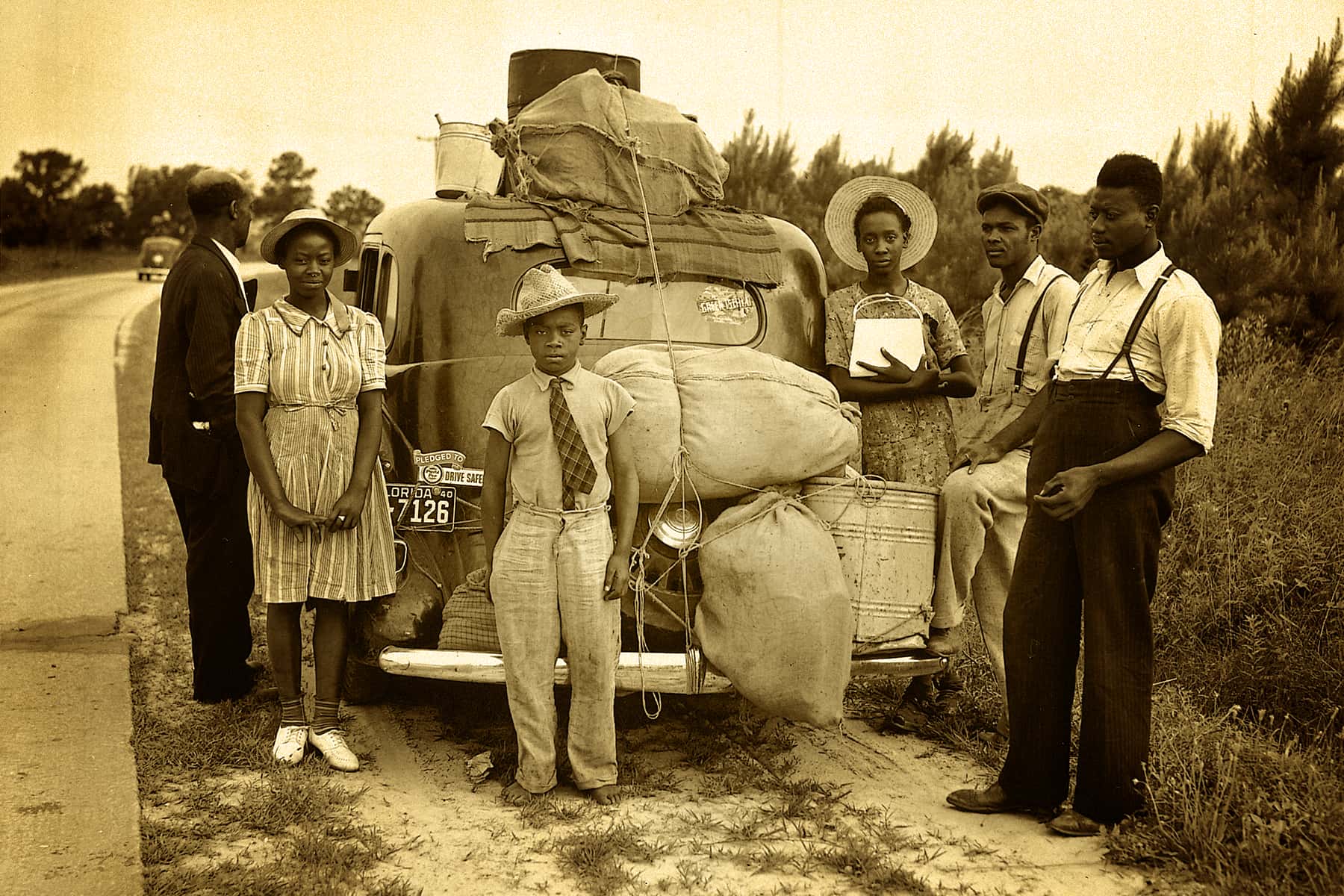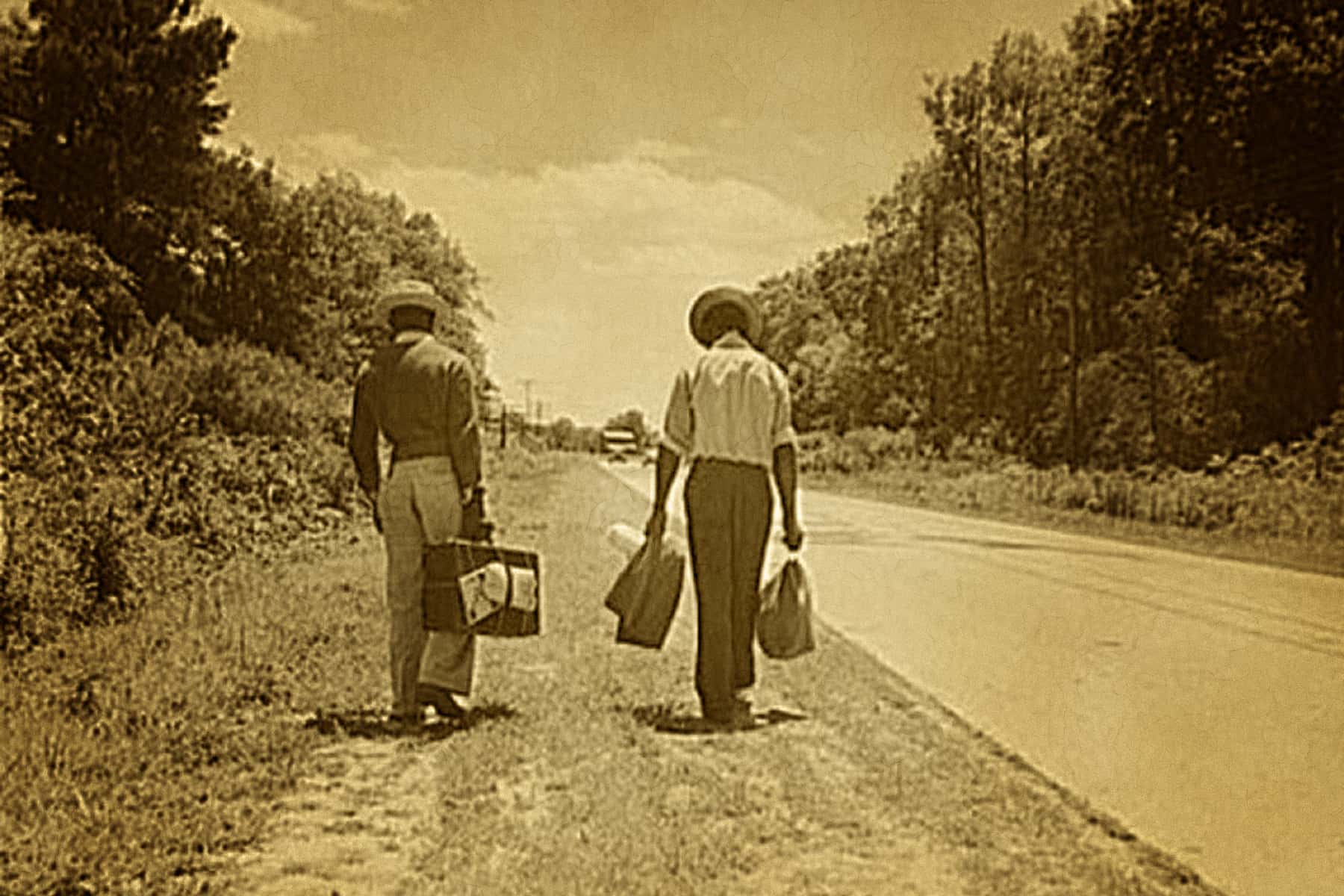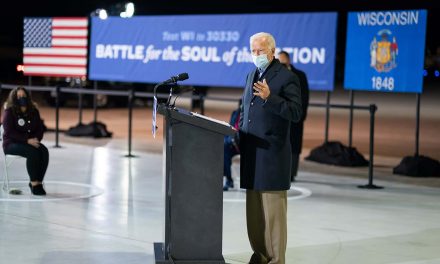
“As enslaved people had children and the enslaved population grew, slaveholders in areas that had once seen massive in-migration of enslaved people through migration and purchase – upcountry South Carolina, central Kentucky, through central Tennessee into northern Alabama, the Natchez District of Mississippi, parts of Georgia and Alabama – found themselves in possession of “surplus” labor. Slaveholders thus enriched themselves not just through slaves’ production of cotton but through their reproduction. This agonizing and traumatic experience of uprooting and separation from families through the domestic slave trade crossed the American South in complicated and ever-changing patterns.” – The Forced Migration of Enslaved People in the United States, University of Richmond, American Panorama Project
In the 1830s through 1850s – as the nation was forcibly moving Native Americans off of the land in Alabama, Florida, Georgia, and Mississippi to make room for whites – two forced migrations took place. The horrible “Trail of Tears,” or “Trail of Death” as some Native Americans call it, was the forced walk from the Southeast into the Oklahoma Territory. Their displacement is just part one of the story.
What most people do not know is that enslaved Africans were sold and, in many cases, forced to walk across the country to the places vacated by these Native Americans. Hundreds of thousands of Native Americans were “removed” to make way for the enslavement of millions of Africans, who were pushed along the well-beaten paths of the domestic slave trade.
Andrew Jackson led the drive to “remove” Native Americans. In 1814 he was the commander of U.S. troops that defeated the Creek nation. They lost over 22 million acres of land in Georgia and Alabama. In 1818 the U.S. attacked the Seminole nation in Florida, which was controlled by the Spanish and not yet part of the United States.
Over a ten-year period, from 1814 to 1824, eleven treaties were signed divesting Native Americans of land in the Southeast in exchange for land in the West. Jackson was instrumental in nine of these treaties. This “voluntary” migration led the U.S. to acquire three-quarters of Alabama and Florida, as well as parts of Georgia, Tennessee, Mississippi, Kentucky, and North Carolina.
A landmark U.S. Supreme Court case, Johnson v. M’Intosh in 1823 changed the fate of Native Americans and enslaved Africans permanently. In that case the court ruled Native Americans do not own the land and private citizens can no longer buy it from them. Chief Justice John Marshall and the court declared Native Americans have only a “right of occupancy” and hold no title to the land. It basically said they could occupy land but not own it. Native American right to own land was subordinate to the United States “right of discovery,” which says title to the land lay with its “discoverer.” Obviously only whites could “discover” it.
After this decision Native Americans began more strongly resisting the efforts to take their land. Some began to assimilate into European values and became farmers, they adopted Western education and even began to enslave Africans. The five nations that did so, the Cherokee, Chickasaw, Choctaw, Creek, and Seminole, began to be called the Five Civilized Tribes by whites. They thought assimilating and adopting white values and customs would protect them from the loss of their land. They were demonstrably wrong.
As is often the case, no good deed goes unpunished. The Five Civilized Tribes would eventually be forcibly removed from their lands, as white settlers demanded that they be given access to it. Some refused to just leave and instead defended themselves.
The first to fight back were the Seminoles and Creeks. The 1783 Treaty of Paris allowed Spain to regain control of Florida from the British. The Spanish offered land grants to settlers that flooded into the territory. The U.S. Army, led by General Andrew Jackson, crossed into Florida and attacked the Seminoles in what became known as the First Seminole War (1817-1818). Africans aided the Seminoles in defending themselves.
For many years Africans had escaped enslavement by running away to join with the Seminole nation in Florida. This infuriated whites that wanted to make the Seminoles pay for providing a refuge for the escaped Africans who the whites had enslaved. The Seminoles were pushed further south into Florida losing land in Georgia and the northern part of Florida.
Under the terms of the 1821 Adams-Onís Treaty, Spain ceded Florida to the United States. The Native Americans were told right away to begin leaving and relocate to Indian Territory, in present day Oklahoma. In 1827 the Cherokee decided to take a different route. They drew up a Constitution declaring themselves to be a sovereign nation. Georgia did not recognize their sovereignty nor did the U.S. Supreme Court after the Creeks petitioned the court for redress of their grievances. They went back to court in 1831 basing their appeal, this time on a 1830 Georgia law prohibiting whites from living on Indian territory after March 31, 1831, without a license from the state.
Despite the fact that the U.S. Supreme Court ruled in their favor this time, Jackson and the state of Georgia refused to abide by the ruling. Jackson was elected President in the 1828 election. He would push a bill called the “Indian Removal Act” in 1830. Both houses of Congress passed the legislation in May. The law allowed the president to “negotiate” removal treaties forcing Native Americans to give up all of their land east of the Mississippi River and move west to Indian Territory.
On December 6, 1830 President Jackson gave a speech before Congress on the importance of Indian removal.
“It gives me pleasure to announce to Congress that the benevolent policy of the Government, steadily pursued for nearly thirty years, in relation to the removal of the Indians beyond the white settlements is approaching to a happy consummation… The consequences of a speedy removal will be important to the United States, to individual States, and to the Indians themselves… it will place a dense and civilized population in large tracts of country now occupied by a few savage hunters. By opening the whole territory between Tennessee on the north and Louisiana on the south to the settlement of the whites it will incalculably strengthen the southwestern frontier and render the adjacent States strong enough to repel future invasions without remote aid. It will relieve the whole State of Mississippi and the western part of Alabama of Indian occupancy, and enable those States to advance rapidly in population, wealth, and power. It will separate the Indians from immediate contact with settlements of whites; free them from the power of the States; enable them to pursue happiness in their own way and under their own rude institutions; will retard the progress of decay, which is lessening their numbers, and perhaps cause them gradually, under the protection of the Government and through the influence of good counsels, to cast off their savage habits and become an interesting, civilized, and Christian community. What good man would prefer a country covered with forests and ranged by a few thousand savages to our extensive Republic, studded with cities, towns, and prosperous farms embellished with all the improvements which art can devise or industry execute, occupied by more than 12,000,000 happy people, and filled with all the blessings of liberty, civilization and religion? Rightly considered, the policy of the General Government toward the red man is not only liberal, but generous. He is unwilling to submit to the laws of the States and mingle with their population. To save him from this alternative, or perhaps utter annihilation, the General Government kindly offers him a new home, and proposes to pay the whole expense of his removal and settlement.”
Some Seminole leaders were forced to sign a treaty in 1832, but many others resisted and were pushed as far south as the Everglades. The Treaty of Payne’s Landing signed in May 1832 forced the Seminoles to give up their land and move west within three years. In 1835 resistance led to the Second Seminole War, which lasted seven years. The United States spent more than $20 million fighting the Seminoles in this war. The Third Seminole War from 1855-58 ended the last efforts to retain their land. By the time the war ended a mere 200 Seminoles remained in Florida and over 3,000 had been forced to move west.
The Creeks never signed a removal treaty but were forcibly defeated by the U.S. Army and in 1836 the Secretary of War demanded their removal as a military necessity. By 1837 over 15,000 Creeks were forced to move west of the Mississippi River. The Chickasaws signed a treaty promising land west of the Mississippi as well, but were forced to flee as whites overtook their land before they had time to prepare to leave.
In 1833 a small group of Cherokee signed a treaty with a removal agreement. Most Cherokees, over 15,000, protested the treaty saying those who signed were not their representatives. The Supreme Court ratified the treaty three years later. Most refused to comply but 7,000 U.S. troops forced them to leave at gunpoint in what the Cherokee refer to as the Trail of Tears. They were given no time to prepare, leaving most of their worldly possessions behind as whites looted their homes. 16,000 were marched to Oklahoma and about 4,000 of them died during the treacherous journey.
Nearly 50,000 had been removed by the late 1830s with many more following in the years after. The forced displacement opening up about 25 million acres that white settlers flooded into, many with their enslaved Africans.
Dempsey Diltz moved to South Carolina, where I believe he became a slaveholder. Eventually he would be one of the hundreds of thousands of whites who re-populated the region vacated by the Native Americans. As was the case with many, he forced the Africans he enslaved to walk to Mississippi from South Carolina.
These Africans he forced to travel with him to Mississippi were my ancestors.
During the 1830s, 60,810 enslaved Africans left South Carolina and were moved to Alabama, Georgia, Mississippi, and Louisiana. 121,769 left Virginia, 55,194 left North Carolina, and 30,250 were forcibly moved from Maryland to the lands where the cotton crop would become King Cotton. 103,280 landed in Mississippi, 108,511 would be moved to Alabama during the next ten years. Altogether more than 300,000 enslaved Africans would be forced to migrate to pick cotton in the rich soils of Alabama and Mississippi, and sugar cane in Louisiana.
Over next decade the trend continued. Mississippi absorbed another, 61,593 and 29,974 went to Alabama while 27,924 were taken to Texas. 92,508 left Virginia headed south and another 50,451 left South Carolina.
In the 1850s the demand for cotton and sugar led to another large forced exodus of enslaved Africans. 55,391 were displaced from South Carolina, and 84,471 from Virginia over ten years. What South Carolina and Virginia’s lost was a gain for Mississippi, Texas, and Louisiana. 64,014 additional enslaved Africans found themselves arriving in Mississippi, while 48,493 landed in Louisiana, and 97,549 ended up in the rich cotton fields of east Texas.
From the time of the prohibition of the importation of Africans on January 1, 1808 until the Civil War ended in 1865, approximately 850,000 enslaved African men, women, and children were forcibly relocated to help grow the economy of the lands opened up by the forcible removal of Native Americans. All of this data can be found at The Forced Migration of Enslaved People in the United States, University of Richmond, American Panorama Project.
The small number that Dempsey Diltz moved from South Carolina included the grand parents of my great grandfather Ed Diltz. They were enslaved in Tillatoba, in Yalobusha County, Mississippi until the Thirteenth Amendment in December ended their enslavement five years after Lincoln’s famous Emancipation.
The document that we all learned about in school did not carry much weight in northern Mississippi where my family was enslaved. The Confederate States of America and their president Jefferson Davis did not recognize the United States government’s power to force them to free anyone. In many areas during the war, Union troops returned enslaved Africans who had fled to their lines after hearing the news of the January 1, 1863 Emancipation Proclamation.
The same year it was issued, the second wife of Dempsey Diltz wrote her last will and testament. As I was tracing my family history many years ago, a woman in California who was a descendant of Dempsey Diltz befriended me. She sent me a complete family tree and other documents from her own family research.
Dempsey Diltz was born in South Carolina in 1798. His family came there from Germany as many others did to start a new life in the British colonies. According to the research, my California friend Becky sent, she had found a record of a Peter Diltz who arrived from Germany aboard ship in 1715. Dempsey’s second wife Mary was born in South Carolina also. In 1820 The Diltz family lived in Edgefield County, South Carolina.
Edgefield County’s southern edge is the Savannah River on the border between South Carolina and Georgia just north of Augusta, Georgia and a very short distance from the Augusta National Golf Club – host of the annual Masters golf tournament. Cherokees and Creeks had been the original inhabitants of the land. The rich soil in Edgefield County in its earliest days made it a perfect place to cultivate cotton. Africans were enslaved to produce the crop.
Sometime during the 1830s Diltz joined the cascade of settlers moving to Mississippi. The 1840 and 1850 decennial census listed Dempsey Diltz as a head of household in Yalobusha County, Mississippi. The listing of enslaved Africans on the U.S. Census was done using what was known as a slave schedule in 1850 and 1860. I found the Slave Schedule for Dempsey Diltz in Yalobusha County completed on August 31, 1850.
It lists a total of fifteen enslaved people. Four of them were females aged 12, 22, and two aged 28. The 11 males ranged in age from 9 months old to 23 years of age. The Slave Schedule listed the enslaved Africans by age, sex, color, and birth year. All were listed as black, with two 4 year-old boys listed as mulatto. This meant that they had one white parent – most likely a white male, which was the norm.
Henry Louis Gates Jr. wrote that, “The average African American today, according to Joanna Mountain at the genetics company 23andMe, “is 73.4 percent African, 24.1 percent European, and only 0.7 percent Native American” in their genetic makeup.”
The glaring omission from the Slave Schedule document was their names. From the 1790 to the 1860 census, enslaved Africans were not listed by name with few exceptions. Free blacks were listed by name. On the eve of the Civil War in 1860 nearly nine of every ten blacks in the country was enslaved. This is why tracing family history is so difficult for those of us of African descent. Unless you are fortunate enough to find someone on the census taken in 1870 or later who was still alive after being enslaved, it becomes a huge roadblock.
Africans were exceptionally valuable “property” for whites. Ownership in black bodies provided, subsistence and wealth for whites in the North and South. Many whites were too poor to afford enslaved people but benefited from working in industries supported by or those that supported slavery. In 1860, 49 percent of white families listed on the census in Mississippi were slaveholders, the highest rate in the nation.
Dempsey Diltz died in 1862 and his wife Mary was left ownership of his property, including the Africans they still enslaved. As I read the terms of her last will and testament from December 1863, I was astonished about what it said.
“I Mary Diltz being of sound and disposing mind but feeble in health do ordain and publish this my last will and testament. I will and bequeath to my son James A. Crozier now residing in Gonzales County, Texas, Three negroes to wit, Bill John and Fillis also one ax mason one bed and bed clothing belonging to the same also the sum of Five Hundred dollars to be paid over by my executor herein after named upon the application of the said Crozier to be paid in Confederate money if the same be on hand at the time of the application, the following negroes to wit Measiah and her three children Emma Mitchell and Ada to be equally divided between my said daughter Mary Ann Swearengen and my said four grandchildren Francis Marian, Mary Catherine, Eliza and Josephine Duke, my daughter Mary Ann Swearengen to have one half of said negroes and the other half to be equally divided between my said grandchildren…if said negroes cannot satisfactorily be divided as above provided for then it is my desire that they be sold by my executors and the proceeds of said sale divided as above stated…”
Mary Diltz went on to bequeath her horse and buggy, beds, and $100 dollars to each grandchild. My family members were included in the property she passed down to her family. She split up my family without blinking an eye. We will never be whole again as a family because America has prioritized devaluing us since we first arrived in 1619. Mary Diltz was simply following protocol and tradition. The damage is permanent. America cannot atone for these wrongs. The trauma has a long reach over multiple generations.
No one can tell me the Emancipation Proclamation mattered in my family, as nearly a year after it was issued they were being given away as an inheritance. Lincoln did not free my family in Mississippi. A careful reading of the document and census research showed me that about 21 percent of the enslaved population were exempt from the terms of the Emancipation Proclamation, and the Confederacy simply ignored it anyway.
Edward E. Baptist aptly describes the journey to the South in his book The Half Has Never Been Told: Slavery and the Making of American Capitalism.
“For eighty years, from the 1780s until 1865, enslaved migrants walked for miles, days, and weeks. Driven south and west over flatlands and mountains, step after step they went farther from home. Stumbling from fatigue, staggering with whiskey – many covered 700 miles – seven hundred miles is a million and a half steps. After weeks of wading rivers, crossing state lines, and climbing mountain roads, and even boarding boats and ships and then disembarking, they had moved their bodies across the frontier between old slavery and new. Over the course of eighty years, almost 1 million people were herded down the road into new slavery.”
This story and many like it are personal to me. When I teach people about the evils of slavery, Jim Crow segregation and racialized institutional violence like lynching, segregation, police brutality, and massive incarceration, I’m telling the stories of America. These are also the stories of my family in America.
Reggie Jackson
Library of Congress
















